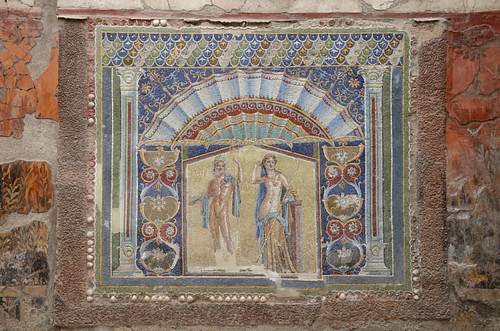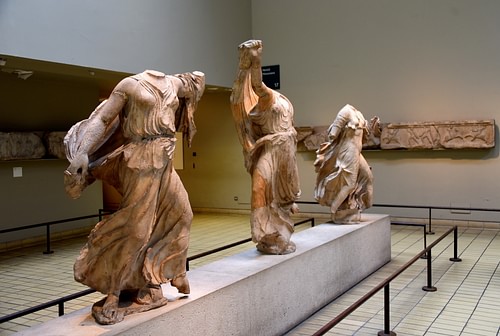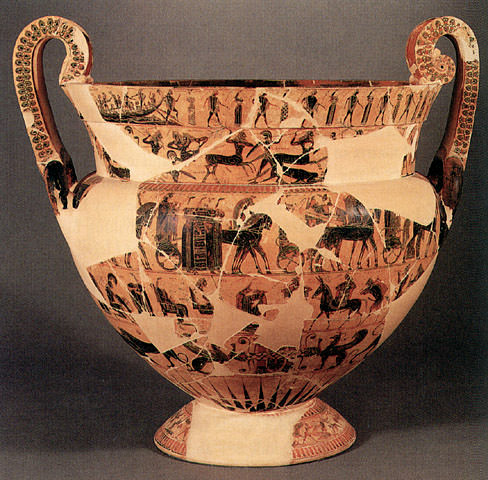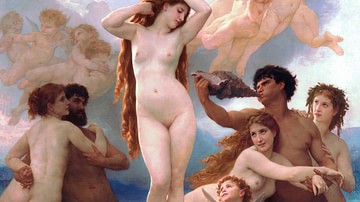
In Greek mythology, Amphitrite is a goddess and the feminine personification of the sea. She is the wife of the Greek sea god, Poseidon, and lives with him in a golden palace beneath the sea. As the daughter of Nereus and Doris, she is one of the 50 Nereids (beautiful sea nymphs).
Amphitrite often resembled Aphrodite in ancient works of art but was identifiable by a crab claw on her forehead, which sometimes resembled a helmet, and by a golden net, she wore in her hair. Her Roman counterpart is Salacia, who was also the goddess of springs. In Homeric poems, Amphitrite is simply known as 'the sea'.
Birth & Family
According to Hesiod (c. 700 BCE) in his Theogony, Amphitrite was the daughter of Nereus, a sea god who was sometimes referred to as the 'old man of the sea', and Doris, an Oceanid who was the daughter of the Titans Oceanus and Tethys. Amphitrite was one of the 50 Nereids.
And Nereus and Doris, lovely-haired
Daughter of Oceanus circling stream,
Begot and bore, in the unfruitful sea,
Their children, most beloved of goddesses:
Protho, Eukrante, Sao, Amphitrite,
Eudore, Thetis, Galene, Glauce, and
Cymothoe, Speio, and quick Thalia,
And lovely Pasithea, Erato and
Eunike with her rosy arms, and fair
Melite, Eulimene, Agave,
Doto, Proto, Pherousa, Dynamene,
Nesaia, Aktaia, Protomedeia, and
Doris, Panope, and the beautiful
Galatea, and the lovely Hippothoe,
Rosy-armed Hipponoe, Cymodoce,
Who, acting with trim-ankled Amphitrite
And Cymatolege, easily can still
Waves on the misty sea, and calm the blasts
Of raging winds.(Hesiod, Theogony, 241-259)
Some sources list her as the daughter of Oceanus and Tethys and refer to her as being an Oceanid rather than a Nereid.
Nereids
The Nereids were beautiful sea nymphs, with the highest-regarded being Amphitrite and her sister Thetis. They are represented in Greek art as sitting on dolphins and holding either tridents or garlands of flowers. Their primary duty was to attend to Poseidon. After Amphitrite married Poseidon, the Nereids became part of their royal court.
They were worshipped by sailors and fishermen with altars dedicated to them located on the seashore. Offerings of oil, honey, and milk were made to them, and sailors invoked them so they may have a favourable voyage and safe return to shores.
As Goddess & Personification of the Sea
Amphitrite was referred to as both a sea goddess and a literal personification of the Mediterranean Sea, a mother to sea creatures like fish, dolphins, and seals. Many ancient writers and poets refer to the sea as Amphitrite, including Homer (c. 750 BCE) in his Odyssey:
No one can say for certain where he died,
whether he went down on land at enemy hands
or out on the open sea in Amphitrite's breakers.(3.99-101)
In the Homeric Hymn to Delian Apollo, Amphitrite is listed as one of the great goddesses who were by Leto's side as she laboured for nine days and nine nights to give birth to Apollo. The great goddesses all gave a great cheer once the beautiful Apollo was born.
Amphitrite & Poseidon
The Greek sea god Poseidon was initially supposed to marry Thetis, a sea nymph and sister of Amphitrite, but quickly backed out of the agreement after being told by the prophet Themis that any son Thetis would bear would be greater than his father. Poseidon first laid eyes on Amphitrite while she was dancing at low tide with her sisters on the isle of Naxos. He immediately fell in love with her and asked for her hand in marriage. Amphitrite, fearful of his tempestuous nature, refused his advances and fled to the Atlas Mountains in North Africa. Amphitrite's reluctance to marry Poseidon mirrors Hera's reluctance to marry Zeus and Persephone's to marry Hades.
Desperate to win Amphitrite's affection, Poseidon sent her gifts of pearls, coral, and sunken treasures, but she still refused to marry him. Finally, Poseidon turned to the dolphin Delphinus for help. Delphinus spoke on behalf of Poseidon so eloquently that Amphitrite had no choice but to give in and agreed to marry Poseidon.

After her marriage to Poseidon, Amphitrite became the goddess of the sea. At her wedding, she was given a wreath of roses from Aphrodite as an acknowledgement of her newfound divinity. To show his gratitude to Delphinus, Poseidon placed him in the heavens, among the stars – this was said to be the origin of the Delphinus Constellation.
Amphitrite and Poseidon lived in a magnificent golden palace under the sea. Amphitrite either rode alongside Poseidon in a pearl shell chariot which was pulled by dolphins or travelled on a dolphin's back. Amphitrite and Poseidon had several children together, including Triton, a half-man and half-fish creature (merman) who lived with his parents underneath the sea, Rhodos or Rhode, wife of the sun god, Helios, and Benthesikyme.

Amphitrite & Theseus
Like his brother Zeus, Poseidon was unfaithful to his wife and had other children with both mortal women and deities. Among the most famous of these children was Theseus, the Greek hero and king, who he had with Aethra, the daughter of King Pittheus of Troezen (some traditions list Theseus' father as King Aegeus of Athens instead of Poseidon).
Amphitrite plays a small part in the myth of Theseus after King Minos of Crete throws a ring into the sea to challenge Theseus' parentage. King Minos dares Theseus to dive into the water and fetch the ring to prove that he is the son of Poseidon. Theseus dives underwater and is carried to Poseidon's palace by dolphins. Amphitrite welcomes Theseus and entertains him amongst the Nereids, treating him as a son of Poseidon. She gifts him a crimson cloak and places the garland of roses that Aphrodite had given her on his head. A triumphant Theseus is carried back to his ship, bearing his divine gifts from Amphitrite.
Amphitrite & Scylla
Scylla was the daughter of Phorcys, a primordial sea god. She was originally a beautiful Naiad who was transformed into a fearsome sea monster. According to most sources, the sorceress Circe was the one who transformed Scylla into a monster. However, some traditions mention Amphitrite as the reason for her transformation.
Poseidon had become enamoured with Scylla, a fact that did not go unnoticed by Amphitrite. She procured some of Circe's magical herbs and poured them into the pool of water that Scylla bathed in. As soon as she entered the water, Scylla was transformed into a barking monster with twelve feet and six heads.
Amphitrite & The Penthelides
The Penthelides (sons of Penthilus of Mycenae) were the first settlers of Lesbos in Greece. They had received an oracle who ordered them to sacrifice a bull to Poseidon and a virgin to Amphitrite and the Nereids to appease them. On the journey to Lesbos, they stopped at the Mesogeion Rock, where the leaders made their daughters draw lots. Phineis, the daughter of Smintheus, drew the short lot and was prepared to be sacrificed to Amphitrite. As Phineis was about to be thrown into the sea, her lover Enalus embraced her and jumped in with her. They were both rescued by dolphins.
Appearance & Worship
There are many depictions of Amphitrite in ancient art where she is portrayed as a beautiful woman who resembles Aphrodite, except for the golden net in her hair and the crab claw on her forehead. She is also a popular figure in post-classical art, where she was shown in stylised sea triumphs. She was often depicted alongside Poseidon, riding a sea horse or dolphin and with a diadem and sceptre as a sign of her divinity. She sometimes also wielded the trident of Poseidon.
According to Greek geographer and writer Pausanias (c. 115-180 CE), there was a statue of Amphitrite in the Temple of Poseidon on the Isthmus of Corinth, and a relief of her on the throne of the Olympian Zeus could be found in the Temple of Apollo at Amyclae in Greece. Today, images of her can still be seen in the form of a colossal statue at the Villa Albani in Rome and on the Arch of Augustus at Rimini, Italy. She is also a popular figure on ancient coins from Syracuse in Sicily. On the famous François Vase (an Attic Krater), Amphitrite and Poseidon can be seen attending the wedding of King Peleus of Phthia and Thetis, riding on a chariot behind Zeus and Hera.
Legacy
As the personification and goddess of the sea, it is no surprise that many ships and yachts throughout history have been named after Amphitrite. This includes seven ships in the British Royal Navy and the Greek royal yacht. There is also an asteroid named after her (known as the 29 Amphitrite). The asteroid orbits between Mars and Jupiter and is located in the central asteroid belt. Amphitrite orbits the Sun every 1,490 days.

In 1936, Australia produced a postage stamp with the image of Amphitrite to commemorate the opening of the telephone wire from Victoria to Tasmania. The stamp shows Amphitrite holding the cable in one hand and a trident in the other.
In Disney's animated TV series Hercules (1998-1999), the character of Amphitrite is voiced by American actress Leslie Mann.










